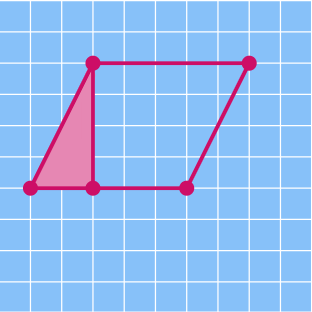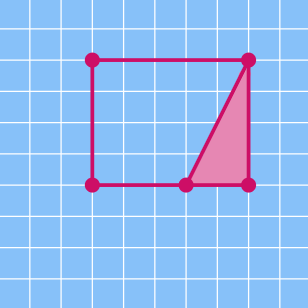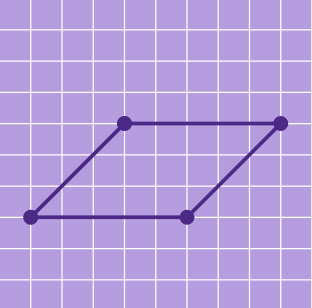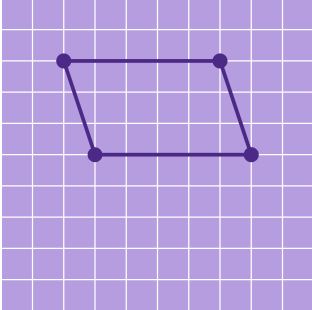Area of a Parallelogram
In real life geometry, the shapes that we encounter are often too complex, which for analysis purposes needs to be simplified into a more primitive version of the shape under consideration. One such shape is that of a parallelogram. The innumerable examples of parallel lines in the physical world is bound to give rise to situations where the concept of parallelogram, becomes unavoidable.

Say, how can we find the area of a land which has the shape of a parallelogram?
Let us find a method to get the area of a parallelogram. Remember, we had mentioned how complex shapes need to be simplified? Think about how we can simplify a parallelogram. Can we make a parallelogram into a rectangle of equal area? To answer this question, let's do an activity.
Method to find area of parallelogram
Activity: Here are step-by-step instructions for transforming a parallelogram into a rectangle on graph paper:
Look at the parallelogram given below on the graphsheet.
Mark a Vertex: Select any vertex of the parallelogram. This will be the starting point for drawing a perpendicular line. For our example lets take A.
Draw a Perpendicular Line: From the chosen vertex, draw a line perpendicular to the opposite side of the parallelogram. This line will intersect the opposite side at a right angle. (From point A, drop a perpendicular to the opposite side i.e. DC)
Create a Triangle: The line you just drew divides the parallelogram into two sections: a triangle and a trapezoid.
Cut Out the Triangle: Click to move the triangle.
The cut-out triangle(filled in red) is taken to the other side of the parallelogram, aligning it such that it fits perfectly with the trapezium. Let's try it here.
Another Method to find area of parallelogram
Using vertex "A", draw a rectangle such that it has the same area as that of the parallelogram. We see that a portion (which is a triangle) is out of the parallelogram bound (say, X).
The area of the "X" triangle is equal to the area of the triangle formed if we drop a perpendicular from A to the side "DC"(say,Y).
A trapezium (known as a trapezoid in North American English) is a four-sided polygon (a quadrilateral) that has at least one pair of parallel sides. The parallel sides are referred to as the bases of the trapezium, and the non-parallel sides are called the legs.

Cutout a triangle from parallelogram so that two adjacent sides are perpendicular to each other

Place cutout on the other side to get a rectangle
What shape is obtained upon doing so? We get a
Is the area of the parallelogram equal to the area of the rectangle formed? (Hint: Count the squares occupied by both the figures)
Yes, area of the parallelogram = area of the rectangle formed.
What are the length and the breadth of the rectangle? The length is equal to the
The length of the rectangle formed is equal to the base of the original parallelogram while the breadth of the rectangle is equal to the height of it.
Thus,
Area of parallelogram = Area of rectangle = length × breadth = l × b
But since, the length l and breadth b of the rectangle are exactly the same as the base "b" and the height "h" respectively, of the parallelogram, the area of parallelogram becomes
= base × height = b × h.
undefined
Area of parallelogram = base × height = b × h
Perimeter of a parallelogram:
The perimeter of a parallelogram is the total distance around its edges. It is calculated by adding the lengths of all its sides. Since opposite sides of a parallelogram are equal, the formula for the perimeter (P) is:
Perimeter of parallelogram = base × height = 2 × (a+b)
where a and b are the lengths of adjacent sides.
Any side of a parallelogram can be chosen as base of the parallelogram. The perpendicular dropped on that side from the opposite vertex is known as height (altitude).

For eg: In the above parallelogram ABCD, BF is the perpendicular to opposite side AD. Here AD is the base and BF is the height
Now let's move on to the perimeter and area calculation for a parallelogram.
Find the areas of the parallelograms by counting the squares enclosed within the figures and also find the perimeters by measuring the sides.
What do you observe?
The perimeter for all the parallelograms in the above example is the
Calculate area and perimeter for the below figures.



The perimeter values are
You will find that these parallelograms have different areas but equal perimeters.
Thus, we now know that:
Parallelograms can have equal areas but different perimeters (or) have different areas but equal perimeters.
Let's Solve
Find the area of following parallelogram:

- We have the values of a base AB and a perpendicular height
- We know that area of parallelogram=
b · h where b- base and h- perpendicular height. - So replace the terms with the b =
, h = - Calculating, and Putting the values, we get the area to be
cm 2 - We have found the required area.
